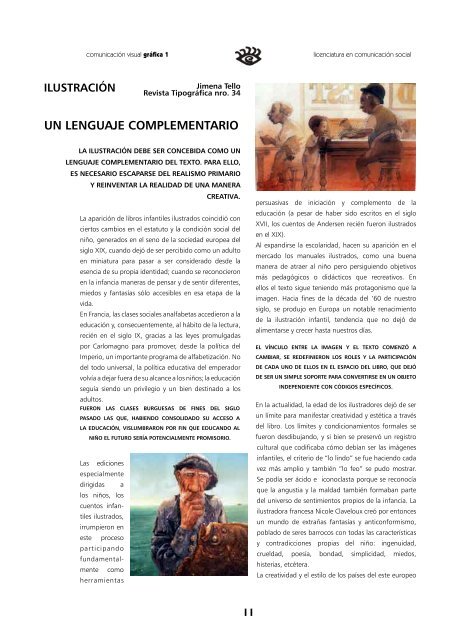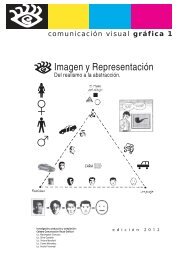El Lenguaje de la Imagen - Comunicación Visual Gráfica I
El Lenguaje de la Imagen - Comunicación Visual Gráfica I
El Lenguaje de la Imagen - Comunicación Visual Gráfica I
You also want an ePaper? Increase the reach of your titles
YUMPU automatically turns print PDFs into web optimized ePapers that Google loves.
ILUSTRACIÓN<br />
comunicación visual gráfica 1 licenciatura en comunicación social<br />
La aparición <strong>de</strong> libros infantiles ilustrados coincidió con<br />
ciertos cambios en el estatuto y <strong>la</strong> condición social <strong>de</strong>l<br />
niño, generados en el seno <strong>de</strong> <strong>la</strong> sociedad europea <strong>de</strong>l<br />
siglo XIX, cuando <strong>de</strong>jó <strong>de</strong> ser percibido como un adulto<br />
en miniatura para pasar a ser consi<strong>de</strong>rado <strong>de</strong>s<strong>de</strong> <strong>la</strong><br />
esencia <strong>de</strong> su propia i<strong>de</strong>ntidad; cuando se reconocieron<br />
en <strong>la</strong> infancia maneras <strong>de</strong> pensar y <strong>de</strong> sentir diferentes,<br />
miedos y fantasías sólo accesibles en esa etapa <strong>de</strong> <strong>la</strong><br />
vida.<br />
En Francia, <strong>la</strong>s c<strong>la</strong>ses sociales analfabetas accedieron a <strong>la</strong><br />
educación y, consecuentemente, al hábito <strong>de</strong> <strong>la</strong> lectura,<br />
recién en el siglo IX, gracias a <strong>la</strong>s leyes promulgadas<br />
por Carlomagno para promover, <strong>de</strong>s<strong>de</strong> <strong>la</strong> política <strong>de</strong>l<br />
Imperio, un importante programa <strong>de</strong> alfabetización. No<br />
<strong>de</strong>l todo universal, <strong>la</strong> política educativa <strong>de</strong>l emperador<br />
volvía a <strong>de</strong>jar fuera <strong>de</strong> su alcance a los niños; <strong>la</strong> educación<br />
seguía siendo un privilegio y un bien <strong>de</strong>stinado a los<br />
adultos.<br />
Las ediciones<br />
especialmente<br />
dirigidas a<br />
los niños, los<br />
cuentos infan-<br />
tiles ilustrados,<br />
irrumpieron en<br />
este proceso<br />
participando<br />
fundamental-<br />
mente como<br />
herramientas<br />
Jimena Tello<br />
Revista Tipográfica nro. 34<br />
UN LENGUAJE COMPLEMENTARIO<br />
LA ILUSTRACIÓN DEBE SER CONCEBIDA COMO UN<br />
LENGUAJE COMPLEMENTARIO DEL TEXTO. PARA ELLO,<br />
ES NECESARIO ESCAPARSE DEL REALISMO PRIMARIO<br />
Y REINVENTAR LA REALIDAD DE UNA MANERA<br />
CREATIVA.<br />
FUERON LAS CLASES BURGUESAS DE FINES DEL SIGLO<br />
PASADO LAS QUE, HABIENDO CONSOLIDADO SU ACCESO A<br />
LA EDUCACIÓN, VISLUMBRARON POR FIN QUE EDUCANDO AL<br />
NIÑO EL FUTURO SERÍA POTENCIALMENTE PROMISORIO.<br />
persuasivas <strong>de</strong> iniciación y complemento <strong>de</strong> <strong>la</strong><br />
educación (a pesar <strong>de</strong> haber sido escritos en el siglo<br />
XVII, los cuentos <strong>de</strong> An<strong>de</strong>rsen recién fueron ilustrados<br />
en el XIX).<br />
Al expandirse <strong>la</strong> esco<strong>la</strong>ridad, hacen su aparición en el<br />
mercado los manuales ilustrados, como una buena<br />
manera <strong>de</strong> atraer al niño pero persiguiendo objetivos<br />
más pedagógicos o didácticos que recreativos. En<br />
ellos el texto sigue teniendo más protagonismo que <strong>la</strong><br />
imagen. Hacia fines <strong>de</strong> <strong>la</strong> década <strong>de</strong>l ’60 <strong>de</strong> nuestro<br />
siglo, se produjo en Europa un notable renacimiento<br />
<strong>de</strong> <strong>la</strong> ilustración infantil, ten<strong>de</strong>ncia que no <strong>de</strong>jó <strong>de</strong><br />
alimentarse y crecer hasta nuestros días.<br />
EL VÍNCULO ENTRE LA IMAGEN Y EL TEXTO COMENZÓ A<br />
CAMBIAR, SE REDEFINIERON LOS ROLES Y LA PARTICIPACIÓN<br />
DE CADA UNO DE ELLOS EN EL ESPACIO DEL LIBRO, QUE DEJÓ<br />
DE SER UN SIMPLE SOPORTE PARA CONVERTIRSE EN UN OBJETO<br />
INDEPENDIENTE CON CÓDIGOS ESPECÍFICOS.<br />
En <strong>la</strong> actualidad, <strong>la</strong> edad <strong>de</strong> los ilustradores <strong>de</strong>jó <strong>de</strong> ser<br />
un límite para manifestar creatividad y estética a través<br />
<strong>de</strong>l libro. Los límites y condicionamientos formales se<br />
fueron <strong>de</strong>sdibujando, y si bien se preservó un registro<br />
cultural que codificaba cómo <strong>de</strong>bían ser <strong>la</strong>s imágenes<br />
infantiles, el criterio <strong>de</strong> “lo lindo” se fue haciendo cada<br />
vez más amplio y también “lo feo” se pudo mostrar.<br />
Se podía ser ácido e iconoc<strong>la</strong>sta porque se reconocía<br />
que <strong>la</strong> angustia y <strong>la</strong> maldad también formaban parte<br />
<strong>de</strong>l universo <strong>de</strong> sentimientos propios <strong>de</strong> <strong>la</strong> infancia. La<br />
ilustradora francesa Nicole C<strong>la</strong>veloux creó por entonces<br />
un mundo <strong>de</strong> extrañas fantasías y anticonformismo,<br />
pob<strong>la</strong>do <strong>de</strong> seres barrocos con todas <strong>la</strong>s características<br />
y contradicciones propias <strong>de</strong>l niño: ingenuidad,<br />
crueldad, poesía, bondad, simplicidad, miedos,<br />
histerias, etcétera.<br />
La creatividad y el estilo <strong>de</strong> los países <strong>de</strong>l este europeo




